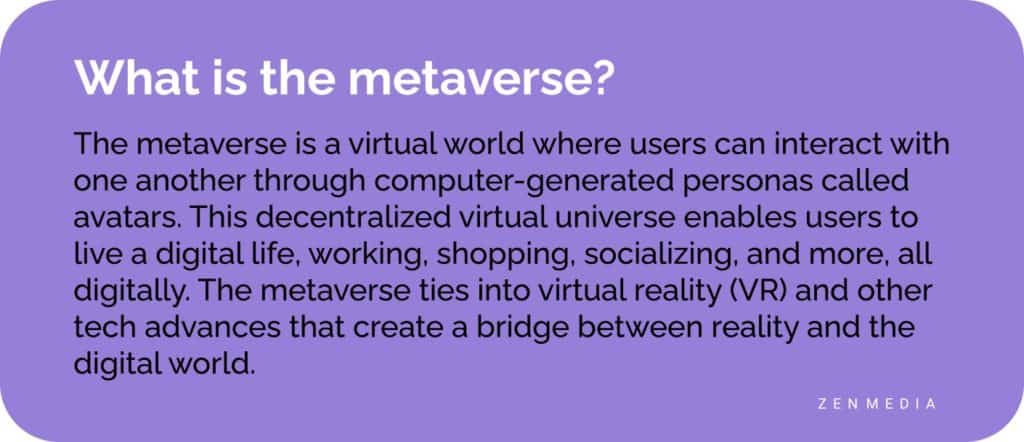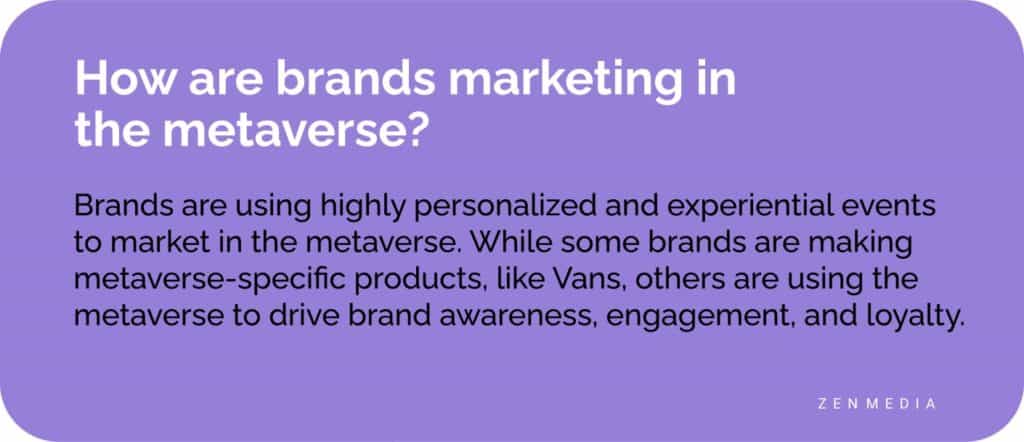The word “metaverse” has found itself in the vernacular of marketers and consumers around the world.
While most are familiar with Facebook’s rebrand to Meta, the term metaverse was actually coined 30 years ago by author Neal Stephenson in his 1992 science fiction novel, “Snow Crash.” Some elements of Stephenson’s metaverse already exist—like virtual reality (VR) headsets and virtual avatars that allow people to interact with the virtual world in a way that mimics real life. But just how blurry the line between reality and fantasy will become is yet to be determined.

The metaverse is still in an infantile stage, but it has had a fascinating development thus far. While many of us anticipated a completely virtual world accessed through VR, our CEO and founder Shama Hyder thinks of the metaverse as more than just a singular place or a collection of virtual shops.
“I think it’s a time in history where our digital identities and our digital presence takes on more and more meaning than even our physical presence,” she explains.
Set up by the pandemic unleashing digital acceleration like never before, the era of the metaverse is certainly a brave new virtual world. But what exactly does that mean for marketing and B2Bs?
Metaverse: The Future of the Internet
Twenty-six percent of Americans—Mark Zuckerberg included—believe the metaverse to be the future of the internet, allowing people to interact with one another, browse the web, play games, watch films, and eventually make purchases—both virtual and physical.
Brands like Chipotle, McDonald’s, and Wendy’s are already experimenting in the metaverse. An early adopter, Chipotle launched a virtual restaurant in the metaverse for Halloween 2021. Visitors could deck out their avatars in Chipotle-themed costumes, navigate the Boorito Maze, and receive codes for free burritos to be redeemed in physical restaurants.
Similarly, the skate-shoe company, Vans, launched a virtual skatepark where players can show off their virtual tricks and earn points to redeem in the virtual store to customize their avatar. According to Forbes, Vans reported 48 million user visits as of December 2021, which is a huge opportunity to build brand awareness and loyalty.
Related post: Here’s How to Build Trust In Your Brand in 2022
It’s important to note that the experiences created by Chipotle, Vans, and more are separate and apart from one another. The word “metaverse” may imply one connected, interwoven universe, but each entity actually owns the access, membership, and monetization rights to the virtual world it creates. This means that business and technical specifications will vary widely as the metaverse continues to evolve into a more immersive landscape than we’ve experienced before.
In addition to the extreme variety in the metaverse and the newness of the concept of itself, there’s no clear adoption in the B2B space—or even with the general public. Still, only 26% of Americans believe the metaverse is the future of the internet, so most people have yet to be convinced to buy in.

How the Metaverse Changes Digital Marketing
On the whole, the pandemic accelerated our behavior as a society. We thrust ourselves into a 24/7 virtual world chock full of immediate gratification. And the metaverse aims to capitalize on that. History teaches us that when change is brought about by major events in our timeline, things don’t always go back to the way they were.
I mean, we all regularly say things like “pre-pandemic” and “post-pandemic” now. We’ve adapted to our “new normal.” And this has happened before. In World War II, women went into the workplace, and even though the war ended and men came back, many women stayed in the workplace. That was the beginning of modern women in the workplace. Similarly, 9/11 brought up the “temporary” TSA regulations. Although we were all told “things will go back to normal,” we know now—more than 20 years later—that those security measures are here to stay.
So what does that have to do with the metaverse? If we view the metaverse more as the acceleration of the importance of our digital presence and less as another platform or strategy we need to develop, it changes our mindset.
What does prioritizing your digital identity look like for your brand? And since consumers each have their own digital identity, how do marketers and brands respect the information around those identities?
The metaverse is meant to let consumers take control of their experience—a process of discovery not often found in traditional B2B marketing. But that level of engagement requires brands to know quite a bit about their consumer. It will no longer suffice to have data that’s representative of the many; consumers in the metaverse will expect individualized attention, so brands need to know each individual consumer’s preferences. With that said, it’s a good thing that the metaverse—as the prioritization of our digital identities—will provide more data than ever before about user experience and preferences, especially now that we are looking at a cookieless future where first-party data is a necessity.
But the idea of operating entirely in VR, building a whole new world to participate in is still a little sci-fi. Think of the metaverse as yet another media to communicate to our consumers through, and that’s really what matters in digital marketing, right? That is what drives our decisions: our consumers. So, if your consumers aren’t early adopters throwing themselves into VR for hours at a time—which B2B buyers are presently not—then throwing your entire budget at it isn’t a good idea.
Will the metaverse have a vast impact on the marketing industry and how we do business? Sure, that’s likely. But is it happening tomorrow? This year? Next year? According to Forrester’s research, it won’t likely happen in 2023.
What marketers need to focus on is the data they collect. Understanding individual customer journeys by monitoring KPIs at various touchpoints will allow you to identify consumers exhibiting predictive behaviors. If there is a pattern emerging, marketers can be prepared to guide consumers through their journey in a personal way while still collecting data to understand each individual’s personal habits and preferences.
And if the virtual world overtakes us and we only operate in a singular metaverse as avatars? Then that skillset and data are still pretty useful.
Related post: What is the Customer Buying Journey?
Using comprehensive analytics, developing and listening to your brand’s user community, and engaging with users on an individual level will be the keys to the kingdom of the future of digital marketing, including the metaverse as it develops.
B2Bs and Metaverse Marketing
Digital marketing is continually evolving. But there is one constant: Establishing a long-term connection with your audience is key in the digital world—sometimes even more so than the physical one.
Before venturing into the metaverse, you need to understand a few things. First and foremost, know if it fits your audience. If you’re aiming for a young demographic, then placing a heavy focus on the virtual world may make sense for you. Understanding the preferences of your audience—how they think and feel about virtual connection—will be imperative in making the decision to dive into the metaverse or not.
Similar to B2B social media marketing, marketers will need to study the brand’s competitors and determine where their brand can enter the relevant conversations happening in the metaverse. Think of it like scanning hashtags for what is trending.
Related post: How To Hashtag Like A Pro
“Entering the conversation” can mean a variety of things depending on the brand and its goals. Perhaps sponsoring events—like a virtual concert or gaming tournament—would excite fans of the brand. Or maybe the target audience is employees, and employers can build virtual offices for remote employees to work together.
But more simply, engaging in the beginnings of metaverse marketing for B2Bs simply means being tuned into your and your consumers’ digital identities. How do they interplay with one another? Is it a dynamic, engaging, and individualized journey? Because that is what “metaverse marketing” really means for B2Bs. It’s not about diving entirely into VR, but prioritizing digital-first experiences that respect an individual’s digital identity and privacy.
The metaverse may not be quite as all-encompassing as we imagined it would be—yet, but there are certainly merits to preparing your brand so that when the metaverse of the future becomes a reality, your brand will already hold a strong digital identity.
Need help navigating metaverse marketing or your brand’s digital identity? Let’s talk.




